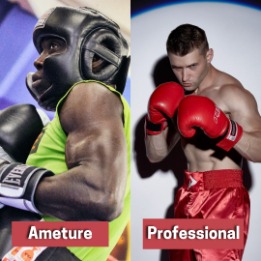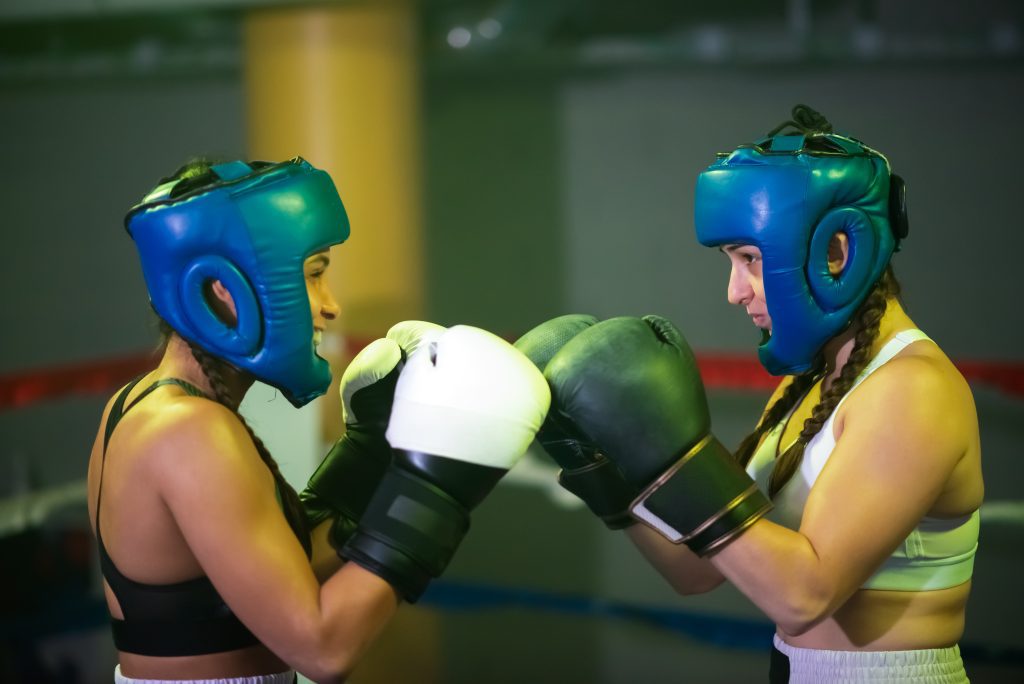Introduction of What is Amateur Boxing and Professional Boxing?: Boxing is one of the oldest and most celebrated sports globally, having evolved from ancient Greek and Roman gladiatorial combat into the organized sport we know today. Modern boxing comes in two primary forms: amateur and professional. While both share the same fundamental techniques and goals, the rules, duration, and purpose of the matches differ significantly. Understanding these differences is essential for anyone interested in pursuing a career in boxing or simply looking to understand the sport better.
This article will explore amateur and professional boxing in detail, highlighting the distinctions between the two, the skill sets required, the career paths, and the financial implications. We will also discuss the impact of both forms on the sport’s culture and the pathways athletes take to transition from one to the other.

Section 1: Defining Amateur Boxing
Amateur boxing is often seen as the foundational level of the sport, where many athletes begin their boxing journey. It is the format used in the Olympics, Commonwealth Games, and other multi-sport events. Unlike professional boxing, amateur bouts are typically shorter and emphasize skill and technique over power and endurance.
- Rules and Regulations:
- Amateur boxing matches generally consist of three rounds of three minutes each.
- Fighters wear protective headgear to minimize injuries.
- Scoring is based on the number of clean punches landed rather than the power of the punches.
- The primary goal is to showcase skill and technique, making it a more strategic form of boxing.
- Training and Preparation:
- Training for amateur boxing focuses heavily on speed, agility, and technique.
- Boxers must maintain a strict weight class, and weigh-ins are conducted the day of the fight.
- Conditioning is crucial, as amateur boxers need to maintain high energy levels throughout the shorter rounds.
- Amateur Boxing Events:
- Olympic Boxing: The pinnacle of amateur boxing, where athletes represent their countries.
- National Championships: A stepping stone for amateur boxers aiming to qualify for international events.
- Golden Gloves: A prestigious amateur boxing tournament in the United States.
Section 2: Defining Professional Boxing
Professional boxing is where the sport’s financial and entertainment aspects come into play. Unlike amateur boxing, where the focus is on skill and technique, professional boxing prioritizes endurance, power, and entertainment. Professional boxers fight for titles, purses, and the potential to become world champions.
- Rules and Regulations:
- Professional bouts can range from four to twelve rounds, with each round lasting three minutes.
- Fighters do not wear headgear, making the sport more dangerous and increasing the risk of injury.
- Scoring is based on a combination of clean punches, power punches, and ring control.
- Knockouts are more common, and the fight can end if a fighter is unable to continue.
- Training and Preparation:
- Professional boxers train for longer bouts, focusing on endurance, power, and resilience.
- Weight management is critical, with weigh-ins typically taking place a day before the fight.
- Professional boxers often have a team, including a coach, nutritionist, and strength and conditioning trainer.
- Professional Boxing Events:
- World Title Fights: The ultimate goal for professional boxers, where they compete for world championships in their weight class.
- Pay-Per-View (PPV) Events: High-profile fights that generate significant revenue and draw massive audiences.
- Boxing Leagues and Promotions: Various organizations, such as the WBA, WBC, IBF, and WBO, sanction professional boxing matches and world title fights.
Section 3: Key Differences Between Amateur and Professional Boxing
While both amateur and professional boxing share commonalities in terms of basic techniques and strategies, there are notable differences that set them apart.
- Duration and Rounds:
- Amateur bouts are shorter, typically three rounds, whereas professional bouts can last up to twelve rounds.
- The shorter duration in amateur boxing means fighters must be quick and efficient, while professional boxing requires more stamina and endurance.
- Scoring System:
- Amateur boxing focuses on the number of clean punches landed, while professional boxing considers the impact and power of the punches.
- In professional boxing, knockouts are more prevalent, and fighters often aim for a decisive finish rather than winning on points.
- Safety Measures:
- Amateur boxers wear protective headgear and have shorter fights, reducing the risk of long-term injuries.
- Professional boxers do not wear headgear, making the sport more dangerous and increasing the likelihood of cuts, concussions, and other injuries.
- Career Progression:
- Amateur boxing serves as a stepping stone to a professional career, with many fighters using their amateur experience to build a foundation.
- Professional boxing offers the potential for fame and financial success, but it also comes with higher risks and a more demanding lifestyle.

Section 4: Transitioning from Amateur to Professional Boxing
For many boxers, the ultimate goal is to transition from amateur to professional boxing. However, this transition is not always straightforward and requires careful planning and preparation.
- Building a Strong Amateur Record:
- A successful amateur career is often a prerequisite for a successful professional career.
- Boxers who excel in amateur tournaments, such as the Olympics or national championships, often attract the attention of professional promoters.
- Securing a Promoter:
- Professional boxing requires a promoter who can secure fights, negotiate contracts, and manage a boxer’s career.
- Promoters play a crucial role in building a boxer’s brand and ensuring they have the opportunity to fight for titles.
- Adapting to Longer Fights:
- The transition from three-round amateur fights to twelve-round professional bouts requires significant changes in training and conditioning.
- Professional boxers must develop the stamina and mental toughness to endure longer fights.
- Financial Considerations:
- Unlike amateur boxing, where athletes often compete for pride and medals, professional boxing is a career that requires financial planning.
- Boxers must manage their earnings, pay for training camps, and plan for their financial future after retirement.
Section 5: The Financial Aspect of Professional Boxing
Professional boxing offers the potential for significant financial rewards, but it also comes with financial risks and challenges.
- Earnings and Purses:
- Professional boxers earn money through fight purses, sponsorships, and endorsements.
- The size of the purse depends on the boxer’s popularity, the importance of the fight, and the negotiation skills of their promoter.
- Sponsorships and Endorsements:
- Successful boxers often attract sponsorship deals from brands looking to capitalize on their popularity.
- Endorsement deals can provide additional income and help boxers build their brand.
- Financial Management:
- Professional boxing careers are often short, so boxers must manage their earnings wisely.
- Financial advisors and managers can help boxers plan for life after boxing and invest their earnings.
- Risks of Financial Mismanagement:
- Many boxers face financial difficulties after retirement due to poor financial planning or mismanagement.
- It is essential for boxers to plan for their future and make smart financial decisions during their careers.
Section 6: The Cultural Impact of Amateur and Professional Boxing
Boxing has a significant cultural impact, both at the amateur and professional levels. The sport has produced legendary figures who have transcended boxing and become global icons.
- Amateur Boxing and National Pride:
- Amateur boxing, particularly in the Olympics, is a source of national pride for many countries.
- Boxers who represent their countries on the international stage become symbols of national identity and achievement.
- Professional Boxing and Global Influence:
- Professional boxing has produced some of the most famous athletes in history, such as Muhammad Ali, Mike Tyson, and Manny Pacquiao.
- These athletes have used their fame to influence social and political issues, making boxing a platform for change.
- Boxing’s Role in Pop Culture:
- Boxing has a significant presence in pop culture, with movies, books, and TV shows often featuring the sport.
- The stories of boxers overcoming adversity resonate with audiences, making boxing a powerful cultural symbol.
- Boxing and Social Impact:
- Boxing gyms often serve as community centers, providing a safe space for young people to learn discipline and stay out of trouble.
- Many boxers use their platform to give back to their communities and inspire the next generation.
Conclusion of What is Amateur Boxing and Professional Boxing?:
Amateur and professional boxing are two distinct forms of the same sport, each with its own set of rules, challenges, and rewards. Amateur boxing serves as a foundation for the sport, emphasizing skill, technique, and national pride. Professional boxing, on the other hand, offers the potential for financial success and global recognition but comes with higher risks and demands.
For aspiring boxers, understanding the differences between amateur and professional boxing is crucial for making informed decisions about their careers. Whether aiming for Olympic glory or a world championship title, boxers must navigate the unique challenges of each level of the sport.
FAQs:
Q1: What is the primary difference between amateur and professional boxing?
The primary difference is that amateur boxing focuses on skill and technique with shorter bouts, while professional boxing emphasizes endurance, power, and entertainment with longer bouts.
Q2: Do amateur boxers get paid?
Amateur boxers do not receive payment for their fights. They compete for medals, titles, and the opportunity to represent their countries in international competitions.
Q3: How can an amateur boxer become a professional?
An amateur boxer can become a professional by building a strong record,
